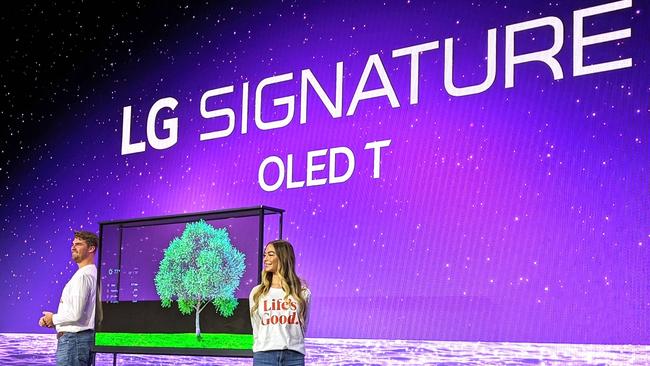How new smarter TVs will transform the viewer experience of the Boxing Day Test
Artificial intelligence will change the way many Australians see the Boxing Day cricket Test as the world’s biggest TV makers harness the technology to make viewing more lifelike.

Business
Don't miss out on the headlines from Business. Followed categories will be added to My News.
Artificial intelligence is about to change how Australians with the right technology see the Boxing Day Test this year.
The world’s biggest TV makers have used the technology to make viewing cricket on the screen more lifelike than ever before.
In a revolution not seen since Kerry Packer recognised the potential of broadcasting cricket in colour in the mid-1970s, AI is being used to solve a common problem when viewing sport on TV: ball distortion.
Television broadcasts at a certain frequency or hertz; think of it as flashing pictures. But to make it appear that a viewer is at the MCG instead of in their lounge room, manufacturers have turned to AI to smooth images and make them more realistic.
To do this, manufacturers need to detect what is viewed to fill in the gaps between the flashing pictures. And in the past it has delivered less than desirable results.
On older models the ball sometimes looks slightly square instead of round for a split second as the TV struggles to identify the sport.
But Samsung says it has solved this problem with its AI Motion Enhancer Pro, which it unveiled earlier this year. The technology automatically detects which sport is being viewed and uses machine learning to apply the proper ball detection model.

It also developed another technology, Motion Rate 200, which helps minimise blur and judder from fast-moving scenes through “the creation or duplication of image frames”. AI is then applied to further sharpen and smooth out motion.
On its 8K TVs, Samsung increases the scale of lower-resolution content to make it appear more lifelike. This extends to its Cricket Gold channel, which taps into Cricket Australia’s archive of old matches.
Processor capability is critical because most content needs to be upscaled from 4K or full HD, given there is so far limited availability of native 8K content.
Electronics giants revealed their latest AI offerings at CES, the world’s biggest consumer electronics show in Las Vegas, in January and have been steadily rolling out their new products this year.
Samsung launched its Neo QLED 8K TV in Australia in April, while LG released its transparent TV in the US last week with “additional markets to follow”. AI is expected to be another big theme at CES – which will be held in early January – and where Samsung will hold a media conference titled “AI for All, everyday, everywhere”.

Like Samsung, LG has been integrating the much-hyped technology across its devices with its Alpha 11 processor enhancing audio and picture quality. Jae-chul Jung, senior vice president and head of LG’s home entertainment R&D lab, said the chip’s neural processing unit delivered a 400 per cent increase in performance.
“(The processor) enables AI-driven features such as enhanced image processing through object detection, pixel level ‘sharpness restoration’, and adaptive colour optimisation,” he said.
“LG TVs can learn from you, adapt and adjust based on your preferences and the way
you use the TV.
“The processor also elevates audio and improves dialogue clarity by isolating
voices from other sounds. These AI-driven enhancements create a more engaging and
personalised viewing experience, tailored by the users’ preferences and made possible by our proprietary technologies.”
Mr Jung said AI was rapidly changing the way households treat their televisions. LG has incorporated a chatbot into its TVs, allowing people to find content via a conversation with their device.
“With the emergence of on-device AI and generative AI, along with rapid advancements in other key technologies, there is now greater demand for TVs and TV-enabled services that can be customised in a similar way to a smartphone or tablet,” he said.
“For example, the ability to set individual profiles on LG TVs means AI learns what you like and recommends the content you want to watch. Or it recognises your voice when you ask a question, and switches to your profile automatically.
“Through advanced voice recognition technologies, utilising large language models (LLMs), LG TVs will be able to understand verbal commands and questions spoken in a more natural, conversational manner.
“Rather than having to use specific phrases for the TV to successfully identify their request, users will be able to talk to their TV in much the same way as they would when conversing with another person.”
Hisense has incorporated AI into its TVs. National retail training manager Chris Mayer said AI Sports Mode allowed for “ultra-smooth motion” at 144 hertz. This compares with 50Hz for regular free-to-air broadcasts.
“With AI Sports Mode, get ready to feel like you’re right in the heart of the action. This revolutionary technology elevates every aspect of your sports viewing experience, and it activates automatically the moment you turn on the game,” Mr Mayer said.
“You'll be surrounded by the roar of the crowd and the thrill of the game thanks to rich, directional audio, all while hearing the commentator's voice loud and clear.”
The Boxing Day Test can be viewed on Foxtel or Seven.
Originally published as How new smarter TVs will transform the viewer experience of the Boxing Day Test



